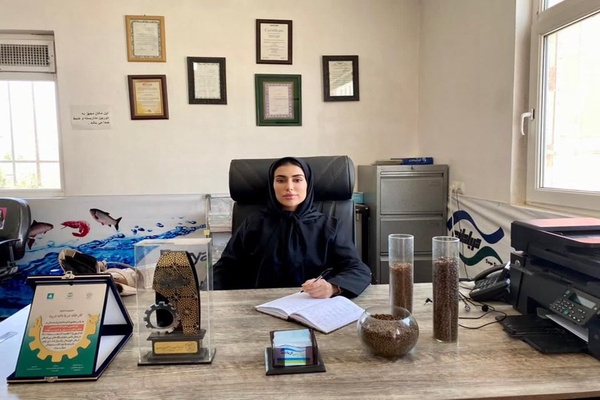No products in the cart.

Algae-Based Feed Production by a Young Woman from Dorud
Zahra Saki, a creative and motivated young woman from Dorud, is the first in the country to produce algae-based aquatic animal feed. She states that the product was developed with an export-oriented approach and aims to generate foreign currency revenue.
Fars News Agency – Lorestan, Nasrin Safarbiranonand:
Zahra Saki, a 21-year-old student majoring in Fisheries, works with her family in the aquatic feed industry. Due to her strong interest in the field, she has actively engaged in this line of work. As a creative and tech-savvy entrepreneur involved in the export of aquatic animals, she noticed that foreign consumers—particularly Russians—value the firmness and texture of fish meat. This observation inspired her to create a type of feed that improves meat quality.
Ms. Saki believes that if tech-based and knowledge-driven companies are provided with sufficient working capital, they can make significant contributions to production and job creation. We sat down with this innovative young entrepreneur to learn more about her algae-based aquatic feed project. Here’s the conversation:
How did the idea for algae-based feed come about?
I work in the lab department of the company and am also in contact with fish farmers. Since we’re active in fish export, and Russian clients care a lot about meat texture and firmness, we realized that fish feed plays a major role in meat quality—alongside water and oxygen. Given that, and our involvement in aquatic feed, I proposed the idea of using algae, which is a marine plant-based protein.
When did you start working on this idea, and how long did it take?
It’s been about a year since I began this project.
How far along are you now?
We’ve completed the research and experimental stages. Thankfully, the results have been promising, and we’re now working toward production and commercialization.
So the product works?
Yes, it’s effective.
What are the benefits of the feed you’ve developed?
Algae improves the quality of fish meat.
Is the feed intended for juvenile fish or adult fish?
Our target is juvenile fish, as the feed boosts their immune systems, reduces mortality, increases appetite and growth, and enhances digestion.
So it’s not suitable for adult fish?
Not really. Given its relatively high cost, it’s more economically viable for juvenile fish, especially since it’s a critical stage in their development where the impact is most significant.
Would you say your work represents an innovation in this field?
Yes. We currently run a tech-based company, and if our idea is patented, it could be upgraded to a knowledge-based company.
Have you considered the market for your feed?
Yes. As I mentioned, our focus is on export-quality fish to generate foreign currency for the province. Lorestan is a hub for cold-water fish farming, so we see great potential here—though we also aim to reach other provinces.
Has a similar product been produced elsewhere in the country?
As far as I know, algae-based aquatic feed hasn’t been produced in Iran yet. We’re planning to launch mass production and bring it to market.
How much did you start with?
We began the experimental and research phase with about 10 million tomans.
Does mass production require machinery and equipment?
For experimental purposes, we produced the feed manually. But for large-scale production, machinery is definitely needed.
If you wanted to scale up, how much investment would you need?
Considering we already have some machinery at our plant, we’d need about 1 to 2 billion tomans to begin mass production.
What would be the employment impact if you scaled up?
Currently, at Darya Daneh Factory—the largest aquatic feed producer in western Iran—we employ 20–25 people directly and about 50 indirectly. If we go into mass production, we could create up to 200 jobs.
So the capability for mass production exists?
Yes, in terms of technical capacity and machinery, we’re ready. Our main challenge is working capital; we’re facing a liquidity shortage. Otherwise, we have the necessary scientific and technical expertise.
End of Report.

